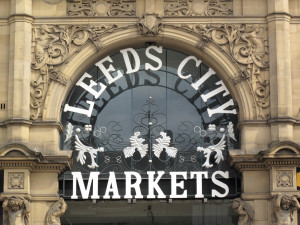
Part of Leeds’ charm is the fine balance between the modern skyline that’s sprung up over the past 20 years and the beautiful period buildings that fill the city centre. Leeds Kirkgate Market is an integral part of the history of Leeds and remains just as popular today as it’s always been. This week we’re going to explore the dramatic history of one of the finest covered markets in Europe.
Origins of the market
Originating in 1822 as an open-air market in one of the most deprived areas of the city, Vicar’s Croft, the market was nowhere near as grand as it is today. It wasn’t until 1857 – a full seven years after the idea was conceived – that the market moved indoors. Inspired by the grand architecture of Crystal Palace, the new Kirkgate market was incredibly popular from the beginning.
Expanding
By 1875 the success of the market led to the purchase of adjoining land and subsequent development and innovation. With the introduction of the cooled ‘fish row’ in 1894, Kirkgate became the largest indoor market in Europe – as well as being one of the most technologically advanced. During this period, new and old sections were housed under the domed glass roof to protect all the traders from the elements – something to be thankful for in the North of England!
By 1899 an on-site abattoir had been installed to complement the new meat market – still one of the finest and most successful in the country.
20th century in Kirkgate
The 20th century brought a new market entrance designed by architects John and Joseph Lemming, who entered a competition to create something worthy of such an esteemed market, and subsequently winning the princely sum of £150. The new hall took nearly four years to build and was completed in 1904. Despite going nearly £40,000 over budget, it was very well received both locally and further afield.
Two world wars
The First World War had no impact on trading, but WWII was altogether a different matter. Although German bombing raids were few and far between this far north, Leeds Market did suffer a hit in 1941 that, fortunately, led to only minimal damage. Traders are tough, though, and the show was soon back on.
The fire of 1975
The cause of the fire is unclear, but we do know that it required over 100 fire-fighters to tame. Causing over £7 million worth of damage, including destroying the roof, it’s remarkable that the 1904 hall was untouched. In true trading tradition, the market was back in action just three days after the fire was put out.
Redevelopment
Over the next 20 years, and after many false starts, the market was repaired, new sections rebuilt and an additional open market with covered stalls was created next to the new bus station. The market that we know and love today is a vibrant and multicultural centre for trade.
With the Leeds Kirkgate Market just a short stroll away from us at Trafalgar Street Car Park, we would be delighted to look after your car while you spend a few hours exploring the stalls. You never know, you might grab yourself a bargain or two, and you’ll certainly be able to pick up everything you need for dinner!

